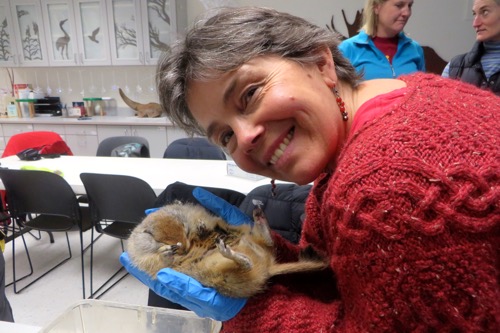Too Cold for a Desert Rat
For a desert rat like me, from New Mexico, Fairbanks, Alaska in February curls the hairs in my nose and chatters my teeth. But yet, Fairbanks, is still balmy compared to the arctic circle, where the mean annual temperature is -10 C.
How does a mammal survive this extreme cold?
At the Museum of the North, I learned that Urocitellus parryii, the arctic ground squirrel has evolved to survive and thrive in this frozen landscape, by hibernating from September to April. Hibernating is not an uncommon survival strategy in cold climates. However, the arctic ground squirrel must also contend with ground that is permanently frozen less than a meter down, a ground which is too hard to dig. So, the arctic ground squirrel cannot escape the freezing temperatures of the land it inhabits. The squirrel's body temperature during hibernation, descends below the freezing point of water, -2 C.
How can this be?
Scientists do not know the full story behind this remarkable feat. The squirrel's blood is somewhat like anti-freeze, which prevents the blood cells from lysing. The squirrel's heart rate slows to one beat per minute, its metabolic rate is 2 % of normal and its breathing slows to about 1 to 3 breaths per minute. In fact, during this extreme hibernation, no brain activity is detected on an EEG (electroencephalogram)!
Forever Young
But the wildest thing I learned about arctic ground squirrels, is that during the long winter slumber, the males' testes are ingested back into their body. So when they arise from their sleep each April, the poor boys begin to produce testosterone again and must undergo puberty each spring!
Thawing from the Freezer
At the Museum of the North, a ground squirrel kept for research and education is kept in a freezer to mimic hibernation. The museum curator, brought out a frozen squirrel for the PolarTREC teachers to hold and admire. The creature was so cold and huddled up in a ball! Over the course of our visit, the squirrel finally began to stir as it warmed in our hands. We returned the squirrel to its freezer before it began to shiver, as shivering is a sign that the body is returning to increased metabolism.
 Arctic Ground Squirrel Cocooned and Frozen
Arctic Ground Squirrel Cocooned and Frozen
 Ground Squirrel emerges slowly from her cocoon of fluff
Ground Squirrel emerges slowly from her cocoon of fluff
 Ground Squirrel curled in a ball, still frozen
Ground Squirrel curled in a ball, still frozen
 The heat of my hands slowly wakens the Squirrel!
The heat of my hands slowly wakens the Squirrel!
Student Contest
Come up with a name for this beautiful Urocitellus parryii and win an Alaskan Prize! Submit squirrel name in the comment section below.


Comments